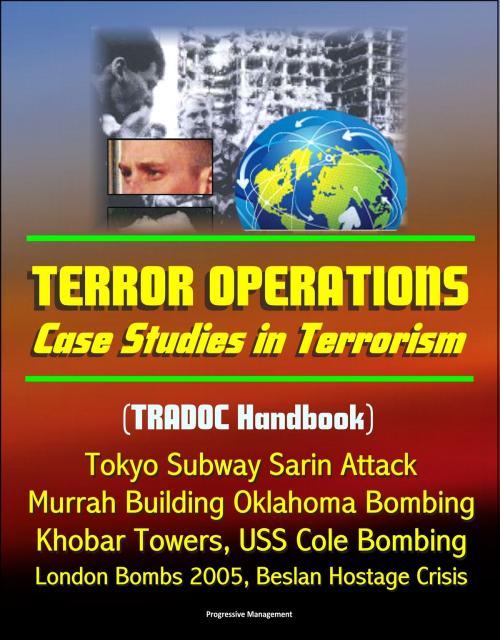Terror Operations: Case Studies in Terrorism (TRADOC Handbook) Tokyo Subway Sarin Attack, Murrah Building Oklahoma Bombing, Khobar Towers, USS Cole Bombing, London Bombs 2005, Beslan Hostage Crisis
Nonfiction, History, Military, Biological & Chemical Warfare, Social & Cultural Studies, Political Science| Author: | Progressive Management | ISBN: | 9781311988119 |
| Publisher: | Progressive Management | Publication: | January 10, 2015 |
| Imprint: | Smashwords Edition | Language: | English |
| Author: | Progressive Management |
| ISBN: | 9781311988119 |
| Publisher: | Progressive Management |
| Publication: | January 10, 2015 |
| Imprint: | Smashwords Edition |
| Language: | English |
Terror Operations: Case Studies in Terrorism is a U.S Army handbook that presents several terrorist incidents in a case study methodology. This document provides an introduction to the nature of terrorism and recognition of terrorist threats to U.S. military forces. A common situational awareness by U.S. military forces considers three principal venues for armed forces: forces that are deployed, forces that are in-transit to or from an operational mission, and forces that are primarily installation or institution support. Compiled from open source materials, this handbook promotes a "Threats" perspective and enemy situational awareness of U.S. strategies and operations in combating terrorism.
This handbook exists primarily for U.S. military forces; however, other applicable groups include interdepartmental, interagency, intergovernmental, civilian contractor, nongovernmental, private volunteer, and humanitarian relief organizations, and the general citizenry. Study of contemporary terrorist motivations and behavior, terrorist goals and objectives, and knowledge of terrorist tactics, techniques, and procedures (TTP) improve training and readiness of U.S. military forces.
The Contemporary Operational Environment * Chapter 1: Tokyo Subway Sarin Attack * Introduction * Learning Objectives * Case Study Overview- Tokyo Chemical Sarin Attack (1995) * Background * Planning and Preparation: Matsumoto - Sarin in the Air * The Decision to Attack Tokyo * Tokyo - Recipe for Disaster * The Sarin Attack * Supplemental Vignettes -The Immediate Aftermath * The Terrorists * The Victims * Case Discussion Questions * Assessment * Chapter 2: Murrah Federal Building Bombing * Introduction * Learning Objectives * Case Study Overview - Murrah Federal Building (1995) * Background * Planning and Preparation: Oklahoma City Target * The Attack with a High Yield Explosive * Supplemental Vignettes: The Immediate Aftermath * Case Discussion Questions * Assessment * Chapter 3: Khobar Towers VBIED Bombing * Introduction * Learning Objectives * Case Study Overview - Khobar Towers Bombing (1996) * Background * Planning and Preparation * The Attack with a VBIED * Supplemental Vignettes: The Immediate Aftermath * Case Discussion Questions * Assessment * Chapter 4: USS Cole Bombing * Introduction * Learning Objectives * Case Study Overview - USS Cole (2000) * Background * Planning and Preparation - Maritime Bombing * The Attack * Supplemental Vignettes: The Immediate Aftermath * Case Discussion Questions * Assessment * Chapter 5: London Bombings of 7 July 2005 * Introduction * Learning Objectives * Case Study - London Bombings of 7 July 2005 * Background * The British Terrorists * Planning and Preparation * The Attacks * The Victims and Emergency Response * Aftermath of Suspicion and the Khan Video * The Media Moment * The Public Response * Case Discussion Questions * Assessment * Implications for the United States * Future Trends? * Chapter 6: Beslan: Hostage Crisis and Mass Murder * Introduction * Learning Objectives * Case Study - Beslan: Hostage Crisis and Mass Murder (2004) * The Terrorists - A Huge Cauldron is Simmering * Planning and Preparation * The Attack * Moments to Mayhem * Case Discussion Questions * Planning for the Future * Reduce Vulnerability to Terrorism * Glossary * Selected Bibliography * Introduction * Tokyo Chemical Sarin Attack * Murrah Federal Building Bombing * Khobar Towers VBIED Bombing * USS Cole Bombing * London Bombings of 7 July 2005 * Beslan: Hostage Crisis and Mass Murder * Footnotes * Terror Operations: Case Studies in Terrorism
Terror Operations: Case Studies in Terrorism is a U.S Army handbook that presents several terrorist incidents in a case study methodology. This document provides an introduction to the nature of terrorism and recognition of terrorist threats to U.S. military forces. A common situational awareness by U.S. military forces considers three principal venues for armed forces: forces that are deployed, forces that are in-transit to or from an operational mission, and forces that are primarily installation or institution support. Compiled from open source materials, this handbook promotes a "Threats" perspective and enemy situational awareness of U.S. strategies and operations in combating terrorism.
This handbook exists primarily for U.S. military forces; however, other applicable groups include interdepartmental, interagency, intergovernmental, civilian contractor, nongovernmental, private volunteer, and humanitarian relief organizations, and the general citizenry. Study of contemporary terrorist motivations and behavior, terrorist goals and objectives, and knowledge of terrorist tactics, techniques, and procedures (TTP) improve training and readiness of U.S. military forces.
The Contemporary Operational Environment * Chapter 1: Tokyo Subway Sarin Attack * Introduction * Learning Objectives * Case Study Overview- Tokyo Chemical Sarin Attack (1995) * Background * Planning and Preparation: Matsumoto - Sarin in the Air * The Decision to Attack Tokyo * Tokyo - Recipe for Disaster * The Sarin Attack * Supplemental Vignettes -The Immediate Aftermath * The Terrorists * The Victims * Case Discussion Questions * Assessment * Chapter 2: Murrah Federal Building Bombing * Introduction * Learning Objectives * Case Study Overview - Murrah Federal Building (1995) * Background * Planning and Preparation: Oklahoma City Target * The Attack with a High Yield Explosive * Supplemental Vignettes: The Immediate Aftermath * Case Discussion Questions * Assessment * Chapter 3: Khobar Towers VBIED Bombing * Introduction * Learning Objectives * Case Study Overview - Khobar Towers Bombing (1996) * Background * Planning and Preparation * The Attack with a VBIED * Supplemental Vignettes: The Immediate Aftermath * Case Discussion Questions * Assessment * Chapter 4: USS Cole Bombing * Introduction * Learning Objectives * Case Study Overview - USS Cole (2000) * Background * Planning and Preparation - Maritime Bombing * The Attack * Supplemental Vignettes: The Immediate Aftermath * Case Discussion Questions * Assessment * Chapter 5: London Bombings of 7 July 2005 * Introduction * Learning Objectives * Case Study - London Bombings of 7 July 2005 * Background * The British Terrorists * Planning and Preparation * The Attacks * The Victims and Emergency Response * Aftermath of Suspicion and the Khan Video * The Media Moment * The Public Response * Case Discussion Questions * Assessment * Implications for the United States * Future Trends? * Chapter 6: Beslan: Hostage Crisis and Mass Murder * Introduction * Learning Objectives * Case Study - Beslan: Hostage Crisis and Mass Murder (2004) * The Terrorists - A Huge Cauldron is Simmering * Planning and Preparation * The Attack * Moments to Mayhem * Case Discussion Questions * Planning for the Future * Reduce Vulnerability to Terrorism * Glossary * Selected Bibliography * Introduction * Tokyo Chemical Sarin Attack * Murrah Federal Building Bombing * Khobar Towers VBIED Bombing * USS Cole Bombing * London Bombings of 7 July 2005 * Beslan: Hostage Crisis and Mass Murder * Footnotes * Terror Operations: Case Studies in Terrorism















